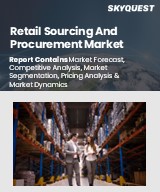
Report ID: SQMIG45A2512
Skyquest Technology's expert advisors have carried out comprehensive research on the retail sourcing and procurement market to identify the major global and regional market trends and growth opportunities for leading players and new entrants in this market. The analysis is based on in-depth primary and secondary research to understand the major market drivers and restraints shaping the future development and growth of the industry.
Drivers
Digitalization Drives Growth in the Retail Sourcing and Procurement Market
Rise in Cloud-Based Platforms Propel Growth
Restraints
Data Security and Compliance Risks
High Implementation Costs
REQUEST FOR SAMPLE
Global Retail Sourcing and Procurement Market size was valued at USD 5.01 Billion in 2023 and is poised to grow from USD 5.82 Billion in 2024 to USD 19.35 Billion by 2032, growing at a CAGR of 16.2% in the forecast period (2025-2032).
The global retail sourcing and procurement industry is highly competitive, driven by the increasing need for cost optimization, supplier collaboration, and digital transformation in retail operations. Major players such as SAP SE, Oracle Corporation, IBM Corporation, GEP, and Jaggaer dominate the market with cloud-based procurement solutions, AI-driven analytics, and automated supplier management tools. These companies focus on enhancing the supply chain visibility, risk management, and sustainability compliance, catering to the evolving needs of global retailers. 'Epicor Software Corporation', 'GT Nexus, an Infor company', 'IBM Corporation', 'Ivalua Inc.', 'Jaggaer', 'JDA Software Group, Inc.', 'Oracle Corporation', 'Proactis Holdings Plc', 'SAP SE', 'Zycus Inc.', 'Oracle', 'Zycus', 'Tradogram', 'GEP'
Increasing digitalization is expected to propel the growth of the retail sourcing and procurement market going forward. Digitalization is referred to as creating a digital representation of physical attributes. For instance, in November 2023, according to the European Central Bank, a Germany-based Central bank, in the second half of 2022, the total number of non-cash payments in the European region increased by 8.8% to 65.9 billion compared to the previous six months. Therefore, the increasing digitization is driving the global retail sourcing and procurement market growth.
Artificial Intelligence-Driven Innovations Enhance Operational Efficiency in Retail Sourcing and Procurement: Payment automation refers to the use of technology to streamline and automate the process of making and receiving payments. Major companies operating in the retail sourcing and procurement market are focusing on developing innovation, such as the payments automation for the extraction of invoice data from scanned documents.
North America led the market with 35.1% of the global revenue share in 2024. The demand for retail sourcing and procurement solutions in this region has been influenced by various factors, including the rapidly evolving retail landscape, supply chain complexities, technological advancements, and changing consumer behaviors. Retailers in economies such as the U.S. and Canada are continuously seeking ways to streamline procurement processes and reduce operational costs, driving substantial demand for solutions that automate sourcing, procurement, and supplier management.
Want to customize this report? This report can be personalized according to your needs. Our analysts and industry experts will work directly with you to understand your requirements and provide you with customized data in a short amount of time. We offer $1000 worth of FREE customization at the time of purchase.
Feedback From Our Clients

Report ID: SQMIG45A2512
sales@skyquestt.com
USA +1 351-333-4748